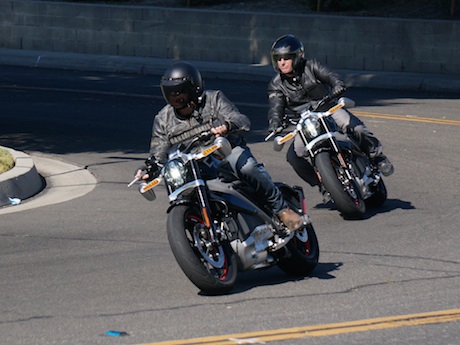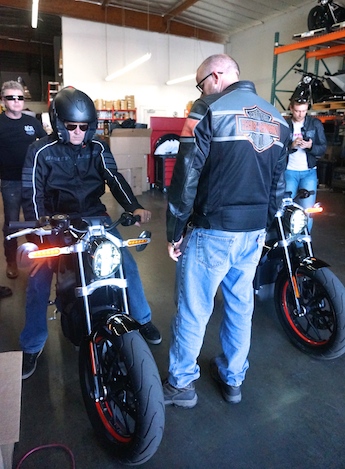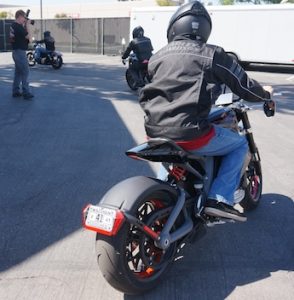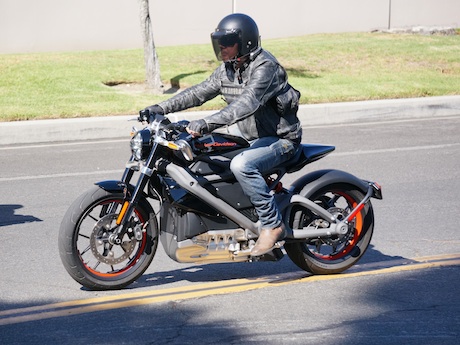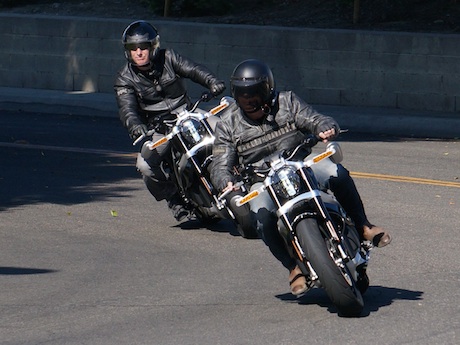There are a three things different about the Harley-Davidson Project LiveWire electric motorcycle from any of the many electric bikes or cars I have experienced: the noise, the braking and the feeling of acceleration.
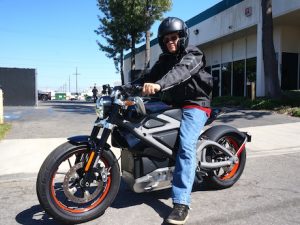
I also noticed the reasonably loud “turbine” noise it made which was a bit of a shock as most electric cars and bikes are almost silent, with only a slight whirring sound. It seems Harley didn’t like the idea of a silent bike, so they meshed the reduction gear to achieve the noise.
I was mightily impressed with the LiveWire. But that was on a static machine and it only left me with the desire to find out what it’s like to ride on the road.
Only a few weeks later I was to get that chance. A lucky handful of Aussie motorcycle journalists in the US for the launch of the 2015 model range were taken to the Harley fleet centre near the LA airport for the honour of trialling the LiveWire on the streets.
It was the Saturday of the Labour Day weekend and the industrial estate and its urban surrounds were eerily quiet so we had a perfect opportunity to give the bike a bit of a “reserved” thrashing. (We still had to be very careful as only 20-odd of these bikes exist and none of us wanted to be the rider who trashed one.)
There were two LiveWire bikes available among a dozen journalists and I was one of the even luckier ones to get the first ride.
Our instructor showed us the basics of operating the machine, which took only a few seconds. You just switch it on like a normal bike, no need for an ignition button. Once it’s on, the computer goes through its diagnostics and you wait until “111” appears on the GPS-sized instruments screen. Then you press another button until that display changes to “0” and you’re ready to go.
But be careful, as the moment you turn the throttle, the LiveWire will go. There is no clutch to let out because there are no gears. All the other controls are very traditional, right down to the Harley left and right self-cancelling indicators on each side.
Before we head out, we all pore over the machine which has immaculate machining, fine detail and a high quality finish as you would expect from Harley. The big electric motor, control unit and battery hang out imposingly under the bike where they can cool. Another noticeable difference from a conventional bike is the lack of messy cabling. The only cables are for the brakes so there are no cables from the left handlebar. It makes for a very clean look.
Throwing a leg over the LiveWire, it feels like any other naked sportsbike. It has a slight lean to the straight bars, a high seat (disappointing for some), high pegs and a hard seat. It’s made for urban riding and canyon carving, not touring or cruising.
I gingerly roll the throttle after having experienced the jerky take-off that is the trait of most electric vehicles (EVs). However, the LiveWire has a very smooth and controllable feel as our instructor has asked us to leave it in “range mode” rather than “sport mode”. He wants to ensure there is enough battery for all of the six groups of riders to have a go on the 4-mile (6.4lm) circuit. (At the end of the test rides, the battery indicates it has 30% charge left.)
But let’s not talk about range at the moment, because that will depend on the final battery that Harley chooses to use if or when the LiveWire finally goes into production. At the moment, they are not even saying what battery they are using, but they claim range is about 100km with a three-and-a-half-hour charging cycle.
In range mode, the LiveWire takes off smoothly which makes slow-speed manoeuvres such as feet-up u-turns very easy. But then it starts to surge, as if you have hit a sweet spot in the powerband. This is unusual in an EV. Most feel like stepping on to an escalator as the maximum amount of torque is available at 0 revs.
Harley has no doubt attenuated the throttle in range mode to reserve power and make it rideable at low speeds, but the spin-off is this awesome feeling of acceleration surge. I wouldn’t put it past Harley to have planned for that as well.
Even in the less powerful range mode, the LiveWire feels as quick as the Zero SR electric bike. We weren’t allowed to try sport mode, but I would hope it would retain that feeling of surge that we love about our conventional bikes.
We were a bit naughty on the bikes, falling back behind our instructor on his Sportster so that we could accelerate and catch up to him, testing the sizzling acceleration of the bike. Even on the suburban streets, it was easy to hit an indicated 80mph (128km/h) in just a few seconds.
On the rolling road, the engine sounded like a whirring turbine, but out on the road, that whir is drowned out by the rush of wind noise. Instead of a turbine whir it sounds more like a tin whistle. I reckon it could get a bit annoying after a while.
But it did turn the heads of passersby as they heard the quiet whoosh of our machines going past. I noticed when other riders had their turn, the LiveWire sounds more like a quiet jet fighter as it goes past.
Like most electric vehicles, the LiveWire uses regenerative braking from the engine to help recharge the battery. It is like a very high-compression engine, only with more effect. In fact, a far greater braking effect than any other EV I have ridden and driven. On several occasions during my short ride, I was able to just roll of the throttle and come to a complete stop at intersections, without having to touch the brakes.
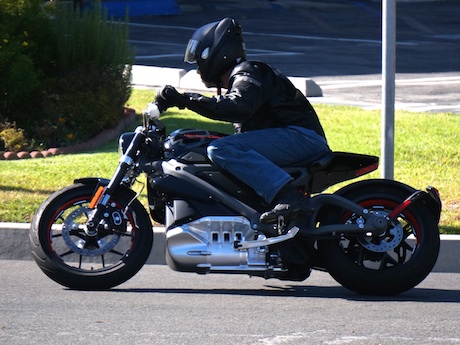
As for ride and handling, LiveWire steers sharply and directly like a sportsbike and feels a little abrupt over surface irregularities. The hard seat would limit how far you could ride just as much as the battery charge would.
Instruments are clear and easy to read even in the bright summer sun and all the controls fall neatly to hand like on a conventional bike.
The LiveWire feels light and very narrow with a skinny tank so you can wrap your legs around it, much like the old Moto Guzzi Le Mans.
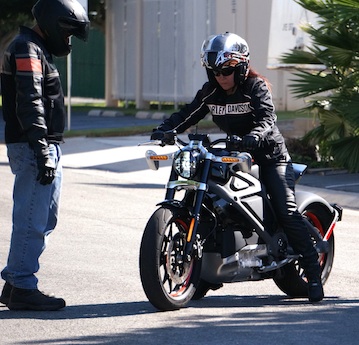
Setting aside battery range and recharging times for the moment, I can see how exciting the LiveWire will be to many people. Unlike other EVs, the LiveWire is more of a “livewire”, thanks to the feeling of speed and its unique noise.
Would I have one? Yes, as a second bike for short blasts and fun commuting.
It all now depends on the price if or when Harley brings the LiveWire to market and the range and recharge times of their final production battery.
Harley-Davidson Australia and New Zealand director of marketing Adam Wright says the LiveWire won’t be at the Melbourne Moto Expo in November but will arrive in Australia sometime next year for more demonstrations and journalist test rides, so stay tuned for a longer test.
Harley-Davidson Project LiveWire
- Motor: AC brushless
- Power: 55kW
- Torque: 70Nm
- Battery: 7kWh, 3.5hr recharge
- Range: under 100km
- 0-100km/h: under 4 seconds
- Top speed: 153km/h (electronically limited)
- Transmission: direct drive, bevel gear
- Chassis: Cast aluminum trellis frame and swingarm
- Brakes: Single discs, 2-piston clipers
- Weight: 208kg
- Wheels: 17-inch rear, 18-inch front


